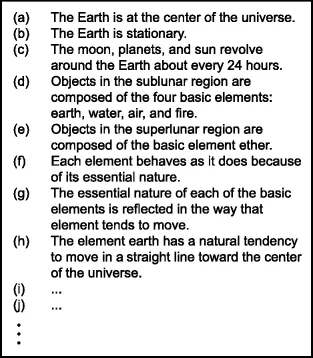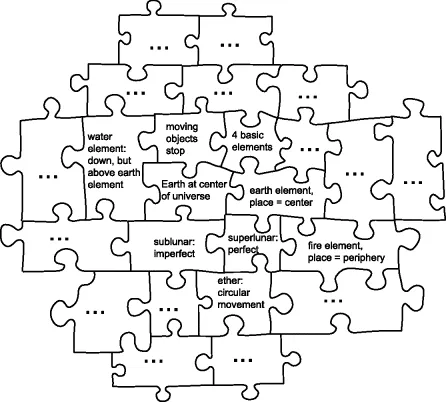
Worldviews
An Introduction to the History and Philosophy of Science
Richard DeWitt
- English
- ePUB (mobile friendly)
- Available on iOS & Android
Worldviews
An Introduction to the History and Philosophy of Science
Richard DeWitt
About This Book
Winner of the 2018 Choice Award for Outstanding Academic Title! PRAISE FOR PREVIOUS EDITIONS
"This is a brilliantly clear introduction (and indeed reframing) of the history and philosophy of science in terms of worldviews and their elements…. In addition, the book is incredibly well-informed from both a scientific and philosophical angle. Highly recommended."
Scientific and Medical Network
"Unlike many other introductions to philosophy of science, DeWitt's book is at once historically informative and philosophically thorough and rigorous. Chapter notes, suggested readings, and references enhance its value."
Choice
"Written in clear and comprehensible prose and supplemented by effective diagrams and examples, Worldviews is an ideal text for anyone new to the history and philosophy of science. As the reader will come to find out, DeWitt is a gifted writer with the unique ability to break down complex and technical concepts into digestible parts, making Worldviews a welcoming and not overwhelming book for the introductory reader."
History and Philosophy of the Life Sciences, vol. 28(2)
Now in its third edition, Worldviews: An Introduction to the History and Philosophy of Science strengthens its reputation as the most accessible and teachable introduction to the history and philosophy of science on the market. Geared toward engaging undergraduates and those approaching the history and philosophy of science for the first time, this intellectually-provocative volume takes advantage of its author's extensive teaching experience, parsing complex ideas using straightforward and sensible examples drawn from the physical sciences.
Building on the foundations which earned the book its critical acclaim, author Richard DeWitt considers fundamental issues in the philosophy of science through the historical worldviews that influenced them, charting the evolution of Western science through the rise and fall of dominant systems of thought. Chapters have been updated to include discussion of recent findings in quantum theory, general relativity, and evolutionary theory, and two new chapters exclusive to the third edition enrich its engagement with radical developments in contemporary science.
At a time in modern history when the nature of truth, fact, and reality seem increasingly controversial, the third edition of Worldviews presents complex concepts with clarity and verve, and prepares inquisitive minds to engage critically with some of the most exciting questions in the philosophy of science.
Frequently asked questions
Information
Part I
Fundamental Issues
1
Worldviews
Aristotle's Beliefs and the Aristotelian Worldview
Aristotle's Beliefs
- The Earth is located at the center of the universe.
- The Earth is stationary, that is, it neither orbits any other body such as the sun, nor spins on its axis.
- The moon, the planets, and the sun revolve around the Earth, completing a revolution about every 24 hours.
- In the sublunar region, that is, the region between the Earth and the moon (including the Earth itself) there are four basic elements, these being earth, water, air, and fire.
- Objects in the superlunar region, that is, the region beyond the moon including the moon, sun, planets, and stars, are composed of a fifth basic element, ether.
- Each of the basic elements has an essential nature, and this essential nature is the reason why the element behaves as it does.
- The essential nature of each of the basic elements is reflected in the way that element tends to move.
- The element earth has a natural tendency to move toward the center of the universe. (That's why rocks fall straight down, since the center of the Earth is the center of the universe.)
- The element water also has a natural tendency to move toward the center of the universe, but its tendency is not as strong as that of the earth element. (That's why, when dirt and water are mixed, both tend to move downward, but the water will eventually end up above the dirt.)
- The element air naturally moves toward a region that is above earth and water, but below fire. (That's why air, when blown into water, bubbles up through the water.)
- The element fire has a natural tendency to move away from the center of the universe. (That's why fire burns upward, through air.)
- The element ether, which composes objects such as the planets and stars, has a natural tendency toward perfectly circular movement. (That's why the planets and stars continuously move in circles about the Earth, that is, about the center of the universe.)
- In the sublunar region, an object in motion will naturally tend to come to a halt, either because the elements composing it have reached their natural place in the universe, or far more often because something (for example, the surface of the Earth) prevents them from continuing toward their natural place.
- An object that is stationary will remain stationary, unless there is some source of motion (either self-motion, as when an object moves toward its natural place in the universe, or an external source of motion, as when I push my pen across my desk).

